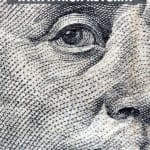Series I savings bonds: A safe investment with a high return

I get a lot of questions about money. These questions tend to vary based on the asker and her needs, but there’s one question I get more often than any other: “What’s a safe investment with a high return?”
For the past decade or so, I’ve had no answer to this question. Savings accounts and certificates of deposit are safe, sure, but they’re no longer attractive investments. Since the Great Recession of 2008/2009, interest rates have remained shockingly low. This is by design. The government doesn’t want you parking your money in a savings account. They want that money out circulating in the economy.
Over the long term, the stock market offers excellent returns. But when people are asking for “safe” investments, they’re wanting avoid short-term volatility, which means stocks are out of the question. (And stuff like Bitcoin and precious metals are even more out of the question!)
Today, however, while catching up on my blog reading, I stumbled upon a link from Michael Kitces’ weekly roundup for financial planners. The story he shared blew my mind. Writing in The Wall Street Journal, Jason Zweig explains the safe, high-return trade hiding in plain sight. (This article is behind a paywall.) That safe, high-return trade? U.S. government Series I savings bonds.
These inflation-adjusted bonds are currently yielding 3.54% annually!
Zweig writes:
Economists say there’s no such thing as a free lunch, but I bonds offer a guarantee from the U.S. government that you can recover your original capital plus any increases in the official cost of living along the way. The only catch is that this isn’t an all-you-can-eat buffet: The maximum purchase is $10,000 per year per account holder (unless you elect to take your tax refund in the form of an I bond).
Ironically, the less you earn and have to invest, the more powerful a tool I bonds are.
Because I was unfamiliar with I Bonds, I spent a couple of hours reading about them today. I think I’m going to begin adding them to my investment portfolio. You might like to also. Let me share what I’ve learned.
The Basics of I Bonds
Series I savings bonds (or simply “I Bonds”) are inflation-indexed bonds with a variable interest rate. That variable rate comprises two components.
- A fixed rate. On the first business day in May and the first business day in November, the U.S. Treasury adjusts this fixed rate for new bonds. But once you purchase a Series I bond, this fixed rate never changes. If the fixed portion of your I Bond is 2.10% when you purchase it, it’ll remain 2.10% for thirty years (or until you sell it).
- A variable rate indexed to inflation. This rate also adjusts at the beginning of May and November. It’s based on changes to the Consumer Price Index. Currently, the “semiannual inflation rate” (as it’s officially known) is 1.77%, which translates into a 3.54% annual rate.
The fixed rate and variable rate components are added together to generate the current composite interest rate. Because inflation can go negative (a.k.a. deflation), the variable rate can also go negative. When that happens, the current yield on your I Bonds can fall below the fixed rate. However, interest on these bonds can never yield below zero. They can never lose value.
Interest compounds every six months. I Bonds are exempt from state and local taxes, but they’re subject to federal income tax when they’re redeemed.
Does that all sound complicated? It’s not, really.
When you buy a Series I bond, you lock in your fixed rate. Then, every six months, the variable rate adjusts based on inflation.
Currently, the fixed rate on Series I savings bonds is zero percent. In fact, the fixed rate has remained below one percent on all Series I bonds issued since May 2008. Why then would you consider adding them to your portfolio? Because despite the low fixed rate, these things still out-earn savings accounts and certificates of deposit.
Now, having said that, cash you put into these bonds is a lot less liquid than the money you put into the bank.
- You must hold the bond for at least one year. You absolutely cannot redeem a Series I bond until it is twelve months old.
- You can redeem the bond after one year. But if you haven’t held the bond for at least five years, you lose the most recent three months of accrued interest.
There are a couple of other drawbacks you need to know about. First, you can only buy I Bonds electronically from Treasury Direct. (This is an official U.S. government site, so it’s safe. Or should be.) Second, you’re only allowed to purchase $10,000 of I bonds each year.
Did I say “only”? I lied. Sort of. You’re also allowed to purchase I Bonds with your income tax refund. Doing so allows you to acquire up to $5000 more in I Bonds each year. And bonds purchased this way are paper bonds, not electronic.
There are other minor things you might want to know about these investment vehicles. If you’d like more info, check out the official Series I Savings Bond FAQ. (And you might also like this table comparing I Bonds to TIPS, Treasury inflation-protected securities.)
I Bonds by the Numbers
Because I’m a money nerd — and because I was curious — I created a spreadsheet that documents historical Series I bond yields since they were released in September 1998. (This is based on the official table from Treasury Direct, but I’ve made it prettier and easy to update in the future.)
This is a wide spreadsheet, so it’ll be unreadable here on this screen. You’ll want to open the image in a new tab. (Clicking on the image should do that for you.) Even then, you may need to manually re-adjust the image size to be able to read it.
Here’s how to read this spreadsheet.
- Each row tracks the interest rate on Series I bonds issued for dates in that range. For example, the “05/08 – 10/08” row tracks how the interest rate has changed on bonds issued between May and October of 2008. The first number in each row (the “fixed rate” in the green column) shows the permanent fixed rate for the bonds issued during that time period. For the “05/08 – 10/08” bonds, that fixed rate was 0.00%.
- Each column tracks semi-annual changes to interest rates. The Treasury adjusts rates on (or soon after) May 1st and November 1st. The top line of each column shows the official inflation rate used to calculate total bond yields. So, you can see that the “May-08” column indicates that the semi-annual inflation rate was 2.42% (meaning annual inflation was 4.84%), and the rest of the column shows effective rates for various bonds.
- I’ve also tried to compile historical data on average certificate of deposit rates. I haven’t found a source I trust and love for this info, though, so am open to recommendations. (I’d also like to find a source for historical savings account data. I’ve been searching for years and have never found anything I like.)
Looking at this spreadsheet, you can see that I Bonds don’t always outperform five-year certificates of deposit — but they usually do. And there have been a couple of occasions when even a one-year CD has offered a better yield for a few months.
The Bottom Line
I have never purchased a savings bond. That’s about to change.
I like the idea of using I Bonds as a vehicle for medium-term investing — saving for a house, saving for college education, etc. If your time horizon is longer than five years but shorter than, say, fifteen years, these are an attractive option, especially if it’s money you cannot afford to lose. Right now, I like them better than a savings account or CD!
For longer time horizons, and for money with which you can take greater risk, you’re better off investing in index funds. Series I bonds won’t earn as much as stocks over the long run. Not based on historical averages, anyhow. But that’s not the point. These bonds aren’t meant for growing your nest egg. They’re meant to keep your nest egg safe.
Even if these don’t appeal to you now, you should keep an eye on Series I bonds to see where their fixed rates go. If they creep up to the three-percent range (as they did 20+ years ago), they’re a terrific deal.
Update: Chris Mamula at Can I Retire Yet? just published an article that compares two inflation-protected government bonds: Series I Bonds vs. TIPS. Useful info there, if this sort of investment interests you.
Become A Money Boss And Join 15,000 Others
Subscribe to the GRS Insider (FREE) and we’ll give you a copy of the Money Boss Manifesto (also FREE)


